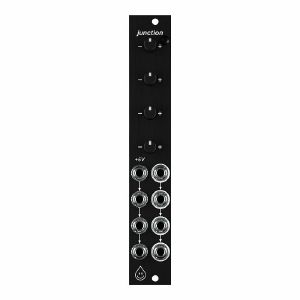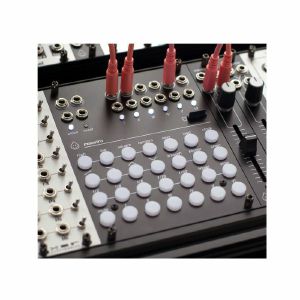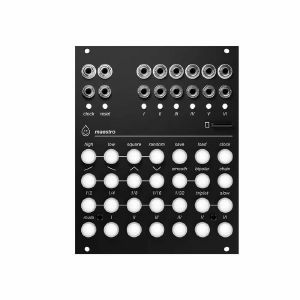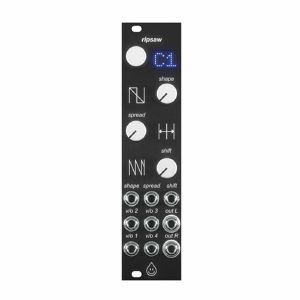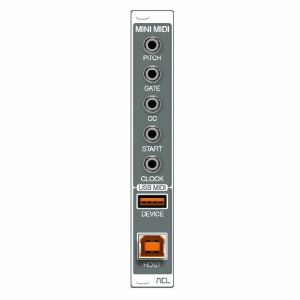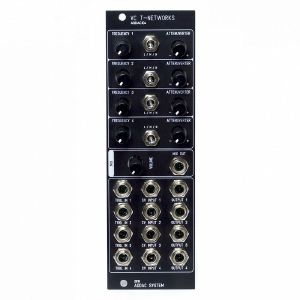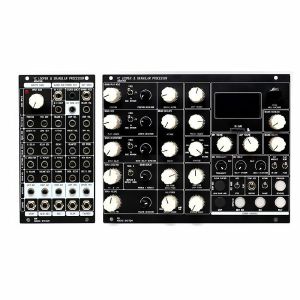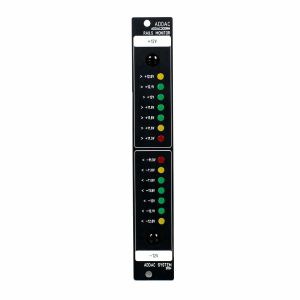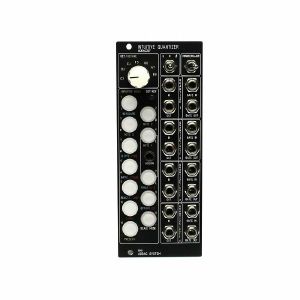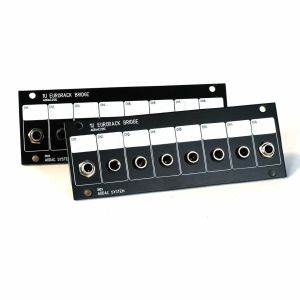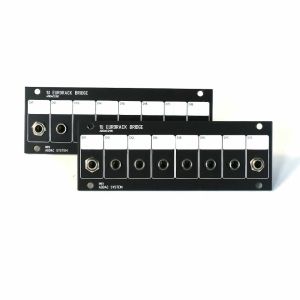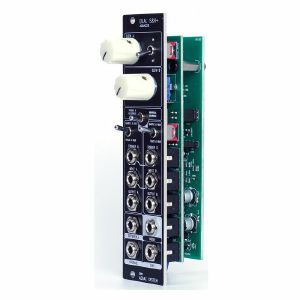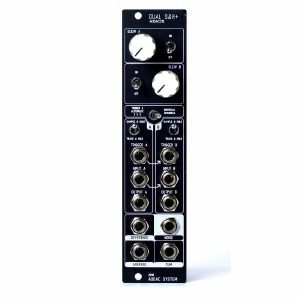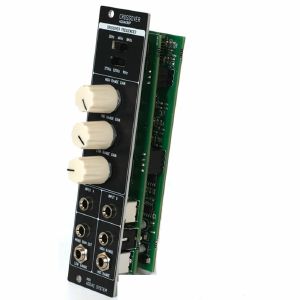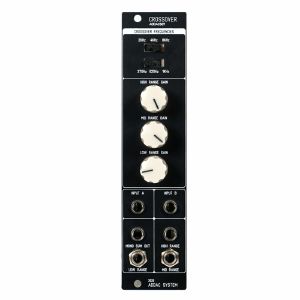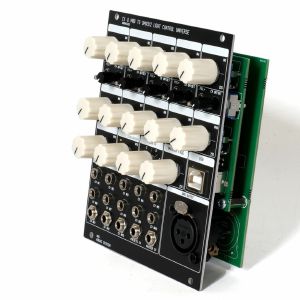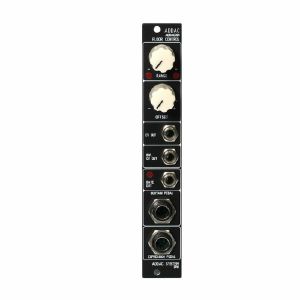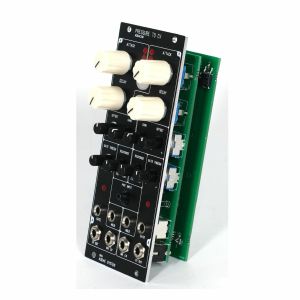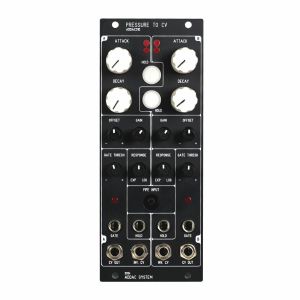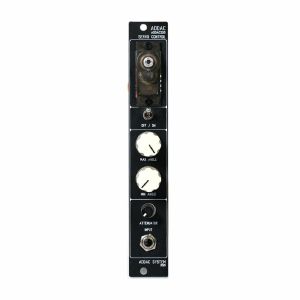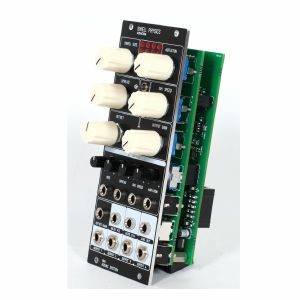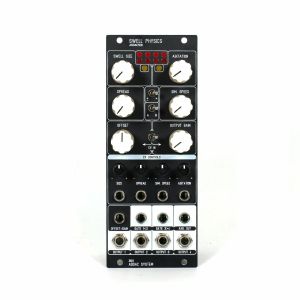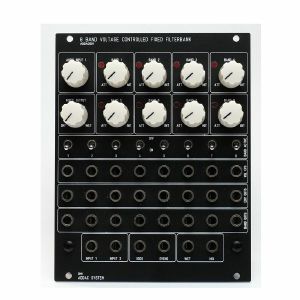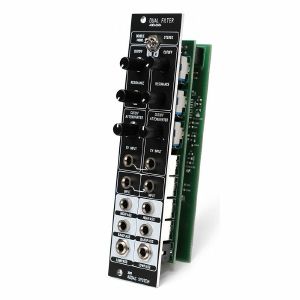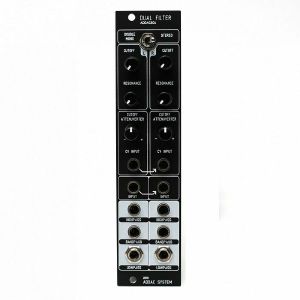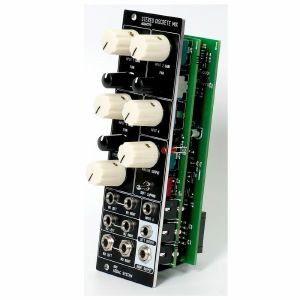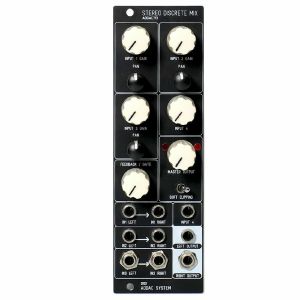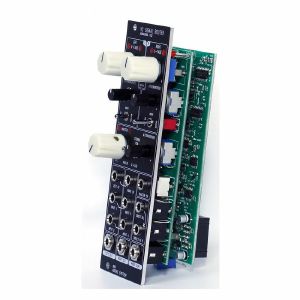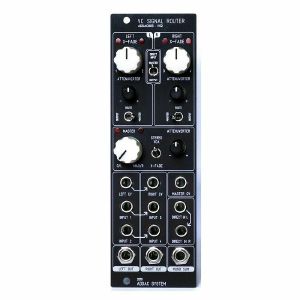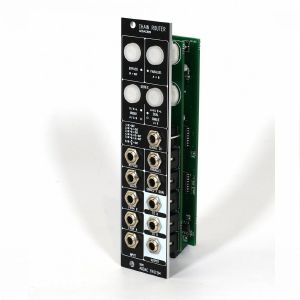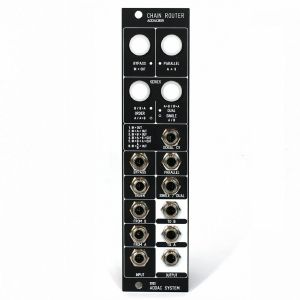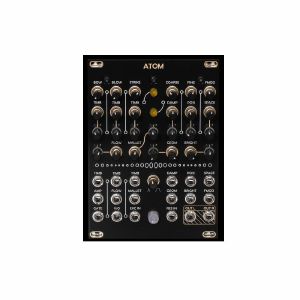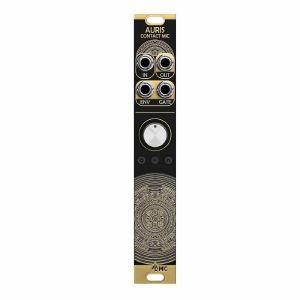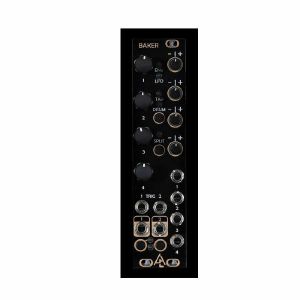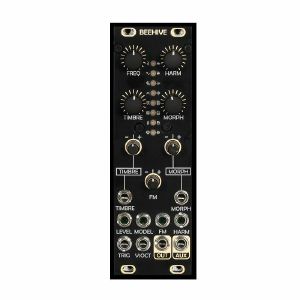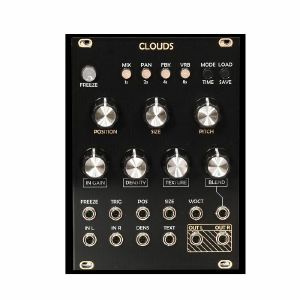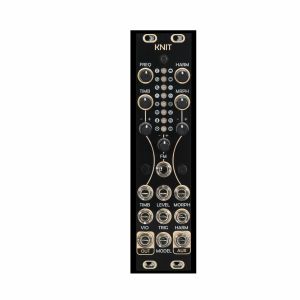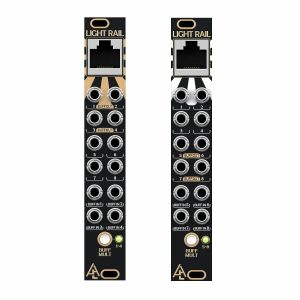Supplier's Notes:
Constellation is all about rhythm. It is an 8 channel pattern generator that works by combining multiple dense and sparse patterns to create long, complex and musically interesting trigger and gate rhythms. Constellation takes a "parametric" approach to rhythm - there is no explicit step sequencing on the module, rather the rhythms are defined by euclidean (and more) parameters that build the rhythm mathematically.
Constellation aims to evolve the concept of euclidean rhythms far beyond the useful but repetitive patterns we often think of when we hear the term "euclidean rhythm". This is accomplished by by combining up to 8 individual euclidean patterns of different lengths and density. Each pattern may provide only a small component of the final output, but together create immensely musical and varied rhythmic material over a very long time frame - up to 999 steps! If each of those steps are 1/16 note in length at 120 bpm, that's a full 2 minutes of explicitly defined, yet non repeating rhythmic material.
In addition, Constellation's parametric approach allows any of these parameters to be modulated with CV through one of 8 freely assignable CV inputs. CV modulation introduces further ability for Constellation's rhythmic output to vary over time. Paired with a Maestro or Navigators, hours of interesting morphing rhythms are possible without the need for tons of step programming or the uncontrollable chaos of a purely generative approach.
When writing music, rhythmic interest is often built through the combination of repeating and non repeating elements that work together to anchor the overall feel but also keep the ear free from boredom over the duration of the piece. Constellation provides a unique set of tools to accomplish this goal and achieve rhythms that are intentional, unexpected and exciting to use as the foundation of your compositions.
28hp, 25mm deep
75mA +12, 18mA -12
quote 872037
enough power available before installing.
About Junction
Junction is a compact, 4 channel attenuverter, cascading mixer and multiple designed to fine tune the control voltages in your rack to the perfect range for their destinations. Junction can be used as a source of fixed voltage, offset another voltage, or mix multiple voltages together to create complex and dynamic modulation.
Features
Each channel on Junction has a knob (1) that acts as a manual control for the attenuverter. Center position (12 o clock) is 0V. The first channel input (2) is normalized to +5V when no cable is plugged into it.
A buffered copy of the input signal of the first channel is present on all of the other inputs from from the first (2) to the last (8). This duplication is "cascading" as shown by the arrow graphics on the panel - if a cable is patched into any input, it "breaks" the cascading multiple - all unpatched inputs carry the signal present at the uppermost patched input (or +5V if no inputs are patched). For example, if a signal is patched into the second channel's input (4) the third (6) and fourth (8) channel inputs would carry a copy of the second channel's input instead of the first channel input.
Junction's channels are mixed on the outputs. The output mixer is also "cascading" - when a cable is patched into an output, it carries a mix of it's own output and all unpatched channel outputs above it. For example, if only the last channel output (9) is patched, this output will carry a mix of all of the outputs. Patching the first channel output (3) would remove it from this mix.
Even though Junction's inputs cascade and outputs mix, Junction's output will clip at the Eurorack power rail voltages of +12 and -12V. It is not possible to output a voltage outside of this range, regardless of the signals patched into Junction.
23mA +12 / 20mA -12 4 HP / 25mm
Deep Reverse Power Protection
1 in stock $112.13
quote 846080
Details:
20hp
25mm deep
65mA on +12, 18mA on -12, 0mA on 5V
quote 804571
Ripsaw contains 4 voices that can each be individually controlled with 1 volt per octave pitch CV.
Seven oscillator spread
Each of Ripsaw's 4 voices contain 7 waveforms that can be detuned from eachother in pitch to create a lush swarm oscillator sound.
Wave morph
Ripsaw's oscillator waveforms morph smoothly from classic sawtooth to square for a hollow, haunting tone when spread detune is introduced.
Super sync
Ripsaw's shift parameter offsets the pitch of a hard sync oscillator for every one of the 28 waveforms to open up a whole new timbral dimension
Hex platform
Ripsaw is only the first firmware to be released on our new 6hp eurorack hardware platform called HEX. Other firmware options that generate and process sound will be available to download and try out free of charge.
Specifications:
6hp
25mm deep
42mA on +12V, 5mA on -12V, 0mA on +5V
quote 1088790
Want to connect your modular system to USB MIDI equipment or computer-based DAWs? Simultaneously? We did too.
With over 20+ modules and three complete modular systems in our portfolio, you'd be forgiven for thinking we're a bunch of purists, roaming the studios of Berlin by night, looking for unsuspecting copies of Ableton Live and Cubase to infect with viruses.
But nothing could be further from the truth. We love analogue hardware, and we also love the power and creativity of DAWs. We love the power and creativity of DAWs, so we've long dreamed of a module to bridge the gap between our computer, modular system, and USB MIDI devices. So we made one.
It's small, and it's MIDI
Mini MIDI draws aesthetic inspiration from a runway model... or a drumstick... or the Taipei 101. Basically it's tall and thin. Nevertheless, this simple, space-saving format contains no less than seven connections: Pitch, Gate, CC, Start, Clock, USB Device, USB Host.
Pitch and Gate are self-explanatory, taking MIDI note information (pitch and note-on/off) from your DAW / keyboard / keytar / USB-whatever, and turning it into something your modular oscillators understand.
CC receives note velocity, aftertouch, or continuous controller information from USB and spits out modular-friendly CV, ready to command anything from filter cut-off to LFO rate.
The CC value to be converted is set using rear panel DIP switches, allowing multiple Mini MIDIs to respond to different CC values from the same DAW / instrument source. You can select from 13 different CC values (if you're superstitious then Mini MIDI is not for you).
The remaining three DIP settings access three additional modes: Note Velocity and Aftertouch modes convert those signals to CV, while Calibration allows precise setting of scale and pitch offset.
Start(stop) and Clock offer no surprises, but if you have a sequencer in your rack you aren't looking for surprises, just a way to trigger it and keep it in time from your DAW and other kit. If this is you, you won't be disappointed.
USB Device lets you connect... wait for it... a USB MIDI device! An obvious use is when you want to use your favourite, gig-friendly, USB controller on stage to control that cut-off, thus keeping your real-estate-guzzling modular rack out of the way (and out of reach of that beer you have perched on a cheap M-Audio controller).
USB Host is the heart of Mini MIDI, bridging the gap between your modular system and a MIDI host device, such as a DAW or hardware MIDI sequencer.
Channel X
We thought hard about MIDI channel assignment. DIP switches are wildly impractical, as you often need to change MIDI channels. A front panel selector would increase the size of a module that's designed to be squeezed into the far left of your rack. (Far left, BTW, because then you can use angled USB connectors and avoid thick cables trailing all over your rack... ). In the end we used 'first come, first served'.
On powering up, Mini MIDI sits patiently waiting for a MIDI signal. Whichever channel it detects first - from Host or Device - is the assigned channel (if your kit is dishing out ALL channels, Mini MIDI will pick the first one... which is 1). And this assignment applies to both USB MIDI connections.
Play nicely with others
Mini MIDI also works perfectly in conjunction with other Mini MIDIs (via multiple computer USB ports or USB hubs). They show up in your system with unique IDs, so each can be triggered by different MIDI channels and/or CC controllers. This can be used to send the same information to different modules/racks in your modular set-up, different information to the same module/rack, or any combination of these. And it can incorporate other USB devices.
Another insanely useful feature is the ability to play your modular set-up live, with a MIDI keyboard or controller, whilst simultaneously recording this information into a MIDI track in your DAW.
Some ultra-modular-types might complain that this is cheating, but they should remember that our grandparents insisted anything made with machines wasn't 'real' music. Chill out and enjoy the possibilities!
Size isn't everything (and other cliches)
Despite its modest appearance, diminutive size, and total lack of front panel controls, Mini MIDI is an exceptionally powerful, highly flexible, and immeasurably useful little module. We designed it to solve the kinds of problems we encountered when using similar modules, and, critically, the kinds of problems our users said they had with other such devices. Consequently, we've exceeded our initial expectations. We hope you feel the same!
Specifications:
DAC: 16 bit
Pitch Output (1V / Octave): -3 V to 7 V
Gate Output: 0 V / 10 V
MIDI CC Output: 0 V to 5 V
MIDI Start / Stop: Active High (5 V)
MIDI Clock: Rising edge (5 V)
USB MIDI Host Interface output current: up to 500 mA
3U Eurorack module, 4 HP wide, compatible with Skiff cases
Current Draw:
+12V: ca. 22mA + current consumption of a connected class compliant USB Device , USB current supply available up to 500mA
-12V: ca. 10mA
0 mA 5V
Installation depth:
30 mm deep
The oscillators and their respective controls, inputs and outputs are organized in four channels. The frequency of each oscillator can be linearly or exponentially (1V/Oct.) controlled through the voltage applied to the corresponding CV input.
Each LFO channel can output one of the predefined waveforms (including sawtooth, ramp, square, sine, triangle), morph between two different waveforms or generate a random waveform. It can be externally reset through the sync input.
Each trigger output can be set to output a specific phase of the corresponding waveform.
The module offers cross frequency modulation (FM) and internal sync between LFO channels. It features also phase distortion and phase spreading of the outputs, including a classical quadrature mode (90- phase spread). Frequency relationships between the four LFOs can also be set.
Hardware
4x CV inputs -5 V to +5 V
4x Sync inputs 0 V to 5 V, active low or active high
4x Clock inputs 0 V to 5 V, active low or active high
4x LFO outputs -5 V to +5 V
4x Trigger outputs 0 V to 10 V, active low or active high
1.8" OLED Display with 160 x 128 pixel
4x push encoder
USB port for firmware update
Size: 14HP
WT-QUAD LFO - Features list:
Wavetable based, 4 channel LFO
Default waveforms: SAW, SQUARE, SINE TRIANGLE
Random waveform generation
Custom wavetables can be loaded using USB flash drive
LFO output: offset and attenuation programmable
LFO Frequency range from 0,0032 Hz to 4 kHz
Frequency free (Hz) or quantized (note)
Presets can be selected through CV input
LFO channel can be internally synced and cross modulated
Single shot modus
2 in stock $543.84
quote 824302
At each voice input there's a gate to trigger converter so any input source is possible.
Audio inputs can also be used as an input, in this case and due to the nature of the gate to trigger converter, each voice can be used as very destructive filters.
The top 2 channels feature a higher frequency range, the bottom 2 channels feature a lower frequency range.
2 in stock $173.80
quote 776116
Supplier's Notes:
There's a long history behind the granular concept and many reinterpretations of it's core principles, this is ADDAC's take on it.
In a loose description digital Granular refer to pieces of sound files being played at the same time with slight or completely different parameters originating what is commonly referred to as granular clouds. Normally there's a buffer size from which the granular engine snips it's pieces from and plays them according to the parameters set. This buffer size is normally small in size where grains are so small that can reach the hearing spectrum and be heard as a sort of ever changing complex wavetable, this is the principle behind granular synthesis.
ADDAC have added the possibility of long buffer sizes up to 5 minutes, allowing "softer" approaches to the granular principle using it as an effect that can generate from "accidental" effects like slight "stutters" to extreme processing and transformation of any incoming audio signal.
This module is conceptually deep but easy to grasp and operate as all controls are in its dedicated panel, all jack inputs and outputs have its own separate panel to allow no compromise when playing it's controls.
There are three main sections in this module:
Looper Engine: The Looper is where all the Real-Time recording happens. The audio input feeds the recording buffer, multiple controls allow to record and play loops into a list so that any sample in the list can be accessed at ay time and more acting as a standard looper
Granular Engine: The Granular acts upon the buffer of whatever LOOP is selected.
Output Mix The output mix allow individual control for the Dry Input, Looper Volume and Grains Volume.
Besides these main sections there's also a simple strip down MENU mainly used to LOAD and SAVE Banks, no Menu diving guaranteed.
For more detailed info, please refer to the User's Guide.
Audio Specs:
Audio input: Stereo, 16bit 44.1Khz
Audio output: Stereo, 16bit 44.1Khz
Tech Specs:
32HP + 13HP
4.5cm deep
240mA +12V
70mA -12V
3 in stock $613.24
Features:
3.5mm jack to BNC including 50O male-male cables.
Ships calibrated set to 10x as default, user's can select 1x but soldering a smd jumper.
Specs:
4HP
15mm deep
Passive
quote 1031331
The Send channels attenuate the synth level to instrument level.
The Return channels amplify the signal from instrument to synth level.
Specs:
- Width: 4 HP
- Depth: 3 cm
- Max current: 10mA
Eurorack +/-12V power rails
Although we all refer to Eurorack PSU voltages as +12V and -12V this is hardly ever the case, although most systems operate at close proximity to this ideal reference, there are situations where the drop from the ideal voltage is large enough to influence the performance of your system.
PSU current ratings
Running a PSU too close to its limits will always cause more stress to the PSU, a good practice it to use only about 75% of your PSU maximum ratings, this will greatly extend the PSU life.
PSUs will show a small voltage drop as current increases which will drastically increase when pushed closed to it's limits. Heat will also influence this drop, heat is related to the current drawn, as more current is being drawn more heat will build up on the PSU, heat conditions will reduce the maxi- mum amount of current that can be delivered by the PSU. While the current consumption drop is somewhat stable and immediate (as you turn the frame on the current consumption will stabilize in a few seconds) the heat drop will take some time to occur, heat will build up over time until it stabilizes and only if it has "headroom" to stabilize. If heat dissipation is not effective than the drop will continue until it reaches a balance point which can be several volts below the 12V reference. At this point your PSU will be under great stress and the heat generated is prone to leave some permanent scars.
Heat will start to have an impact at about an ambient temperature of 50 degrees celsius, at 70 degrees the maxi- mum current rating will drop by 50%. If your PSU is rated at 2A maximum and it's running at 70 degrees then it will only be able to deliver 1A maximum.
For the PSU this is a complex balancing act as current influences heat and heat influences the maximum amount of current available which all together influences the voltage drop.
This is why it's so important to keep the PSU load at a sensible level.
PSU protections
Some PSUs feature over voltage, over current and overheating protection and will turn off when the operating conditions trigger any of the protection threshold levels.
At this point it's typical that the PSU will enter a Hiccup mode, where it turns on checks the current conditions and quickly turns off if they haven't changed, leaving it in an intermittent limbo where it powers on and off at some regular frequency.
If the conditions change enough to drop below the protection threshold levels then the PSU will automatically recover and stay on.
PSU stress
Different situations can be responsible for causing stress that can damage the PSU, it's possible to reverse a ribbon power cable enough times or leaving it connected long enough to partly damage the PSU.
Another situation is having a module that due to some partial previous damage may be drawing more current than specified which will not be accounted for when calculating your system current consumption.
Stress can cause permanent damage to the PSU, however some damages can be only partial leaving you with a PSU that no longer features the specs described by the manufacturer but with no apparent misbehaviour. The LED monitors on bus boards will be on, but in reality it will be underperforming at an unknown percentage of the original specs. These situations can be quite hard to debug without the proper tools to evaluate the cause of the problem.
PSU impact on modules
Some modules are more susceptible to PSU changes than others, modules that feature internal regulators will be less susceptible to PSU voltage, modules that use internal +5v, +/-9v, +/-10v regulators will have more tolerance than modules that use the PSU voltages directly like it is for most cases. Also modules that use voltage reverse protection will already have a 0.3v to 0.8v drop inherent to the protection circuit.
While many digital modules can withstand lower voltages some others will be more dependent on the reference voltage and may show strange behaviours.
This module can help preventing all these situations, it won't fix any problem but can help on the day-to-day monitoring of your system and in keeping your PSU in healthy conditions.
Tech Specs: 4HP/3,5 cm deep
60mA +12V
60mA -12V
quote 1028712
Mechanical:
Format: Eurorack
Width: 10 HP
Depth: 5.2 cm
Control Voltage I/O:
CV inputs: i 5v
CV outputs: +10v
Electrical:
Max current: +140mA/-70mA
Bus Board Cable: 8 × 2 IDC (Doepfer style) connector
quote 776182
Standalone use:
Two ADDAC213C modules can be connected to each other with the use of a single ribbon cable and then used inside a case to carry signals between distant points without the need for long cables. Less clutter, less spaghetti, more space of your fingers on those knobs!
ADDAC213Cs always come in pairs. A single pair can send & receive up to 8 CV or audio signals between different points in your case at the same time.
Do you have modules that you often use together in different areas of your case? Would you prefer that each row's cables don't mingle with cables from other rows? Grab yourself a pair of ADDAC213s.
As an Expansion to an ADDAC213A:
Each ADDAC213C connected to the backside of an ADDAC213A adds 8 more channels to the main bridging functionality of the ADDAC213A.
Up to 2 ADDAC213C can be connected to an ADDAC213A module, expanding the bridging between two difference cases to a total of 24 channels.
If you're looking for a simple one-cable bridge between your various cases, then look no further than the ADDAC213A.
Between the ADDAC213A pair and the ADDAC213B, your cases never looked so elegantly connected together!
Check ADDAC213A for more information:
https://www.addacsystem.com/en/products/modules/addac200-series/addac213a
Price is for a pair of modules (2 modules) including two 50cm ribbon cables, only one is used to connect the two ADDAC213C together but two are necessary when connecting the two ADDAC213C to two ADDAC213A.
Comes with a 50cm ribbon cable. Custom sizes are available upon request.
Mechanical:
. Format: 1U Eurorack
. Width: 22HP
. Depth: 2.5 cm
Electrical:
Passive / Does not draw current
Ribbon Cable: 50cm or 100cm ribbon cable (custom sizes available upon request)
2 in stock $88.58
At its core it features a noise source and two precision Sample & Holds with 0.01% of maximum deviation from the Input which allows for quantized signals to be sent through without any noticeable detuning or the typical voltage drops over time.
The Sample & Hold sections can also be used as a Track & Hold meaning it holds the incoming input while the Trigger input is ON and lets the input flow to the output when the Trigger input is OFF.
Each section also features it's own slew processor with a single control over attack and decay and an ON/OFF switch.
The noise signal is normalled to both sections inputs, meaning that without a jack plugged into the Input the sample and hold function will act upon the incoming noise signal generating random CV values.
The [Trigger A Alternate] switch allows to Link both sections so that any trigger input in Trigger A will alternate between triggering the A and B section.
Besides each section outputs there's also 4 extra outputs: Noise, Difference, Average and Sum. The Noise output is coming from the noise source, the Difference output is the subtraction of section A minus section B, the Average output is the sum of both A plus B and then divided by 2 and finally the Sum output is the sum of both A plus B sections.
MECHANICAL:
Format: Eurorack
Width: 6 HP
Depth: 4 cm
ELECTRICAL:
Max current: +50mA/-50mA
Bus Board Cable: 8 × 2 IDC (Doepfer style) connector
quote 776254
Using a 3.5mm TRS stereo jack input, the module splits the TRS stereo signal into 2 mono outputs (Left + Right) while also converting the line input to synth level.
There are 2 independent sections allowing for two stereo sources to be connected.
Tech Specs: 3HP, 4 cm deep, 20mA +12V, 20mA -12V
quote 1052227
It merges 2 TS mono signals (Left + Right) into a TRS stereo output while also converts the synth inputs to line level.
There are 3 independent sections allowing for three stereo sources to be connected.
Tech Specs: 3HP, 1.5 cm deep, Passive module
quote 1052230
Introducing the ADDAC607, which enables users to split the signal into different bands. This creates many interesting processing possibilities. For example, by independently processing specific frequency ranges, one can add delay on only the high frequency range. Or, users split a signal to feed three different compressors for multi-band compression. Finally, DJs can use the Gain knob as a 'kill switch' to remove an entire frequency band, if desired.
Although ADDAC607 operates in Mono (for Stereo signals two modules can be used) there are two audio inputs, making it easy to achieve stereo to mono summing. The Mono Sum Out carries this summed signal. This is pre-gain and can also be used as a buffered Thru output.
The ADDAC607 is a great companion to the ADDAC220 Dual Envelope Follower+, since it allows extraction of dynamics from any signal in a focused frequency range. This allows it to separate the frequencies of a kick drum and a snare, for instance.
This product is available for pre-order at Juno, for shipping on the release date. You won’t be charged until the order is despatched.
We'll keep you informed of your order at every stage, and let you know if the release date changes.
If the price of the item drops before it's released, you will pay the lower price, but if it increases, you'll only pay the price you see today.
If you also include in-stock items on your order, they’ll be charged and shipped within 24 hours as usual.The level of an incoming audio signal gain can be set by using the Gain control. Then, the signal is then fully rectified and passed through an analog envelope follower with a fixed short attack and decay. The analog signal is then sent into a 12bit ADC (analog to digital converter) of an MCU (microcontroller unit), and hereafter the signal is processed digitally. Whenever the ADC detects audio clipping the Clip led will light up.
Then, the digitized signal is then passed through a Savitsky-Golay filter for noise reduction smoothing of the incoming signal, before it is slewed using the Attack and Decay controls. The MCU keeps a history of the last sampling points and detects the minimum and maximum values, which reflect the current dynamic range and maps the signal minimum and maximum amplitude to 0V and the maximum voltage detected.
This new mapped signal is then processed via the Response Curve control balacing the response like one would with a standard AD envelope with LOG/EXP control. The Envelope Gain attenuverter control goes up to x2 amplification and sets the attenuation / amplification factor of the output range, while the red LED monitors this level with precise visualization across the full output range
This product is available for pre-order at Juno, for shipping on the release date. You won’t be charged until the order is despatched.
We'll keep you informed of your order at every stage, and let you know if the release date changes.
If the price of the item drops before it's released, you will pay the lower price, but if it increases, you'll only pay the price you see today.
If you also include in-stock items on your order, they’ll be charged and shipped within 24 hours as usual.Together with the ADDAC220 Dual Envelope Follower+ & ADDAC607 Crossover it becomes quite easy to create a system for sound to light reaction using both audio amplitude and spectrum translation. Such a system features "no" latency when compared to a digital implementation as all amplitude detection and spectrum separation is done in the analogue realm.
The 13 CV inputs can be assigned to any of the 512 DMX channels using the configuration webpage using Google Chrome:
http://media.addacsystem.com/ADDAC223
There are 30 Slots for 30 different assigns each assigns defines a CV Input and a DMX channel. CV inputs can be assigned to different DMX channels
Check the User's Guide for a more in depth description.
MIDI to DMX512
When connected to a computer MIDI can be sent to directly to the DMX Network via the module.
Sending a CC message on any of the first 4 MIDI channels will control any of the DMX 512 channels.
The DMX value will be the CC Value * 2 (as MIDI resolution is 0/127 and DMX is 0/255)
MIDI CHANNEL 1 > CC 0 to 127 --> DMX CHANNEL 1 to 128
MIDI CHANNEL 2 > CC 0 to 127 --> DMX CHANNEL 129 to 256
MIDI CHANNEL 3 > CC 0 to 127 --> DMX CHANNEL 257 to 384
MIDI CHANNEL 4 > CC 0 to 127 --> DMX CHANNEL 385 to 512
This allows for precise control of any DMX fixture in the network straight from your favorite DAW and sequence any fixture's functions just like any other midi device.
Use MAX, Pure Data, Processing, Python and these can be generated, randomized....
Make sure not to overlap DMX channels that are being controlled over MIDI and over CV.
Tech Specs:
20HP
4.5cm deep
80mA +12V
80mA -12V
This product is available for pre-order at Juno, for shipping on the release date. You won’t be charged until the order is despatched.
We'll keep you informed of your order at every stage, and let you know if the release date changes.
If the price of the item drops before it's released, you will pay the lower price, but if it increases, you'll only pay the price you see today.
If you also include in-stock items on your order, they’ll be charged and shipped within 24 hours as usual.It's also normal to have an expression pedal lying around somewhere, so ADDAC have brought these back, cleaned up the dust and put them to good use.
This module allows the connection of any standard expression and sustain pedal.
The expression pedal action can be fine-tuned with Range and Offset knobs.
Range defines the voltage range (-10v, +10v).
Offset transposes the range by (-5v, +5v).
Two leds, plus and minus, monitor the CV Output
Positive and inverted output jacks.
The sustain pedal action will generate a gate signal on the gate output.
One led monitors this output.
The module also features a bus board +5v Adaptor, this will be able to provide +5v to any bus board.
This feature can be removed through a jumper on the back of the module.
Specs:
- Width: 4 HP
- Depth: 4 cm
- Max current: 20mA
. Bus Board Cable: 8 × 2 IDC (Doepfer style) connector
The ADDAC304 comes with an interesting twist: 4 out of the 8 available gates can act as momentary switches, outputting the signals in their respective inputs when each gate's button is pressed.
MECHANICAL:
Format: Eurorack
Width: 8 HP
Depth: 2.5 cm
CONTROL VOLTAGE I/O:
CV inputs: i 10v
Gate outputs: 0 +5v
ELECTRICAL:
Max current: 10mA
quote 776300
Supplier's Notes:
This module expands ADDAC's line of expressive controls, it follows the heritage of wind/breath controllers with one major difference, the pipe has no air escape creating pressure inside the tube controlled by the user's mouth. For a seasoned woodwind or brass musicians this working principle may sound unorthodox, however this way pressure can be controlled for longer without the need to breath in or learning circular breathing techniques. It's relatively easy to control the pressure in your mouth while still breathing through the nose.
The module is provided with a standard melodica pipe which connects to an air filter (providing a receptacle for condensation to form and isolate the sensor) and lastly connects to the module frontpanel.
The signal captured by the sensor is then sent to two independent sections with exactly the same functions as seen in the signal flow diagram below.
As an example the two sections can be used with different settings to independently control the VCA and VCF of any standard analogue voice patch.
Pipe
ADDAC are using a standard Melodica pipe into an air filter that will keep condensation away from the sensor. The air filter is then connected to the frontpanel sensor input using a silicone tube.
Sensor calibration
[RESPONSE] is the main control to calibrate the pressure curve, the knob goes from exponential to logarithmic with linear at 12 o'clock. Exponential will be more reactive to high pressures, logarithmic to lower pressures.
Hold function
This feature allows to hold the current voltage value with the hold is engaged (button led on), the state can be changed either by the push button in a latching manner (push to change state) or via the gate input in a momentary manner (hold on while gate is on)
Extra Pipe
Extra Pipes are available separately.
Tech Specs:
10HP
4.5cm deep
70mA +12V
40mA -12V
quote 1034160
A servo is a specific type of motor that can be digitally controlled to work at precise angles. On the ADDAC320, it is controlled by a microcontroller which is able to receive an incoming CV voltage from 0 to +5v and linearly converts this voltage range to the 270 degree Servo motor range. Using a spring wire and metal couplers, the motor shaft is then attached to the target knob to be controlled, which will turn as the Servo turns.?Two other knobs, Maximum Angle and Minimum Angle, allow further control of the "sweet spot" of the target knob, establishing a smaller Servo range.
This product is available for pre-order at Juno, for shipping on the release date. You won’t be charged until the order is despatched.
We'll keep you informed of your order at every stage, and let you know if the release date changes.
If the price of the item drops before it's released, you will pay the lower price, but if it increases, you'll only pay the price you see today.
If you also include in-stock items on your order, they’ll be charged and shipped within 24 hours as usual.The concept is simple. It contains two identical smooth random voltage generators. Each has a frequency, level, offset and curve control. The frequency control sets a steady pace with which bipolar random voltages are generated. The level control works like an attenuator/VCA on the output, reaching from max output to closed. The offset allows shifting the whole wave up and down on the voltage range. Curve determines the shape of the interpolation.The bipolar activity on the main outputs as well as gate outputs are visualised with LEDs.
Both Frequency and Level controls have a CV input with attenuator. When there is nothing patched into the CV inputs, these are internally connected to the main output of the other channel. This normalization makes it very easy to add randomization to the frequency or level for more depth, or of course, add cross-modulation for chaotic voltages.
The output VCAs are usefull to dial in subtle and time-based modulation without the need for external VCAs. For example, to modulate the amount over time with an envelope, or use the other generator with slower speeds to add random changes to the level of a random voltage.
Both generators also have two other outputs. One is an exact inversion of the main output, so it responds to the level and CV input. This is great for stereo or inversed effect patches. The other is a simple pulse output, here there are two different behaviours, channel A outputs a pulse at every random generation, channel B acts like a comparator. Whenever the main is positive this comparator output is a high gate. And whenever the main output is negative or close to 0, there is no gate output. Great for random triggers or firing other events like envelopes.
A couple other outputs are also available and are obtained by averaging both channel main outputs. The first output is the average while the second is an inverted average.
Tech Specs:
10HP
4.5cm deep
70mA +12V
40mA -12V
3 in stock $289.29
Supplier's Notes:
Following ADDAC's ADDC503 Marble Physics here is a new simulation of a physical system. This time, imagine a small area in the middle of the ocean, in this area we place 4 equally spaced buoys anchored to the bottom in such a system that we can control the spacing between the buoys. Imagine we can control the elements and agitate the waters at will which in turn will make the buoys move up and down as the water surface moves.
Finally imagine the buoys would wirelessly transmit their absolute height directly to your module outputs where they would be mapped to a voltage signal.
ADDAC use a Gerstner Wave as the motor behind the two-dimensional wave generation. In fluid dynamics a Gerstner Wave is described as "a progressive wave of permanent form on the surface of an incompressible fluid of infinite depth". Gerstner waves are often used in computer graphics to simulate any type of water surface, if you've seen any animation film or computer game with water surfaces in it most probably it features a Gerstner wave generating it.
Tech Specs:
10HP
4.5cm deep
70mA +12V
40mA -12V
quote 993830
Supplier's Notes:
The ADDAC601 Analog Filterbank will have you shaping the spectrum of your sound "tout de suite".
With its 8 fixed frequencies, this very special filterbank has two additional features that you won't find anywhere else. Each of the 8 band volumes can be controlled through a linear high performance VCA, which adds great dynamics and new abilities to the art of filtering. Additionally this module also doubles as an envelope follower, with a dedicated CV output per band.
It features numerous output options: you can select between individual bands, the full processed sound, a wet/dry signal and even choose between odd or even frequencies.
Plus you can add up to two different signals, which are mixed internally by the ADDAC601 inputs.
- Format: Eurorack
- Width: 20 HP
- Depth: 5.5 cm
Control Voltage I/O:
- CV inputs: i 5v
- CV outputs: 0 - 10v
Electrical:
. Compatible with +-12v and +-15v power supplies
. Max current: +340mA/-350mA
. Bus Board Cable: 8 × 2 IDC (Doepfer style) connector
2 in stock $382.37
Supplier's Notes:
While developing the ADDAC105 4 Voice Cluster module, a new multimode filter to place after the summing mix stage- and the results were so postitive that it was released as a dedicated filter.
To make it more interesting, the circuitry was duplicated, to be able to use it in a stereo signal path.
To make it more versatile, a switch was added to set the working mode from Stereo to Dual Mono where both filters can be used independently.
In Stereo Mode the Left Cutoff is used to control the Right Cutoff.
In this case the Right Cutoff Knob and CV Input are simply bypassed and will have no impact on the Right Channel operation.
This allows immediate sync of both filter frequencies when the Stereo position is engaged.
Optionally there's a jumper in it's back that, when placed, connects the Right Controls back to the Right CV control allowing the possibility to control the offset of the Right Channel Cutoff.
Resonance is independent on both Modes and still has to be set manually to match both channels.
Both the Audio and CV inputs are normalled from the Left into the Right channels.
As standard plugging any input to the Right channels removes this connection.
Tech Specs:
6HP
4 cm deep
70mA +12V
70mA -12V
3 in stock $161.46
quote 776353
Supplier's Notes:
ADDAC713 is the stereo version of ADDAC System's 703 Discrete Mixer.
Inspired by Moog's CP3 mixer, this is a fully discrete analogue mixer and it's not, by any means, your standard breakfast mixer, although it can behave like one.
This is a wolf in sheep's clothing. Despite its harmless looks there's a dark snarly soul behind that panel that wants to take your sounds into a realm of gritty gnarly growls.
This new version was initially thought of as a percussion mixer, with mono inputs and panning, to allow placing percussive voices in the stereo field, while keeping channel 4 in mono for low end sources like a kick drum or Bass. In the development process ADDAC System slightly changed this initial idea, adding stereo inputs for the first 3 channels, but still kept the 4th channel in mono.
All four [GAIN] controls go to extreme levels, the first 3channels also feature [PAN] controls. Feedback is used to overdrive the whole mix. As the control is turned clockwise the sound will be clipped harder until it goes completely off, this happens as feedback is increased the audio bias reference also moves up, at extreme levels it offsets the whole signal upwards until it completely goes above the top rail clipping the whole signal hence the resulting gate effect.
The [MASTER OUTPUT] sets the overall output gain of the mixer, the two leds monitor the audio output signal. The Soft clipping switch engages an anti-click circuit which adds a low pass before the output, the switch allows 3 states: Soft low pass / Off / Hard low pass.
Features:
Three channels with stereo inputs, gain and pan knob
One channel with mono input and gainknob
Feedback/gate knob
Master output volume knob
Soft clipping switch
Two Led Monitors for Left and Right channels
Tech Specs:
8HP
4cm deep
80mA +12V
80mA -12V
1 in stock $224.26
Featuring two dedicated X-faders and a stereo VCA that can also be used as a third X-Fader. All controls have their own CV inputs and dedicated Attenuverters for precision control.
4 quadrant mixing is achieved by using the stereo Master as a X-fader between left and right channels, this way you can plug 4 audio sources and sweep/crossfade between each and any of them using the 3 x-faders. Plug any 4 sources (4 waveforms of a VCO, 4 LFOs, 4 envelopes...) and sweep through morph through or have them all mixed together.
For other configuration types Left and Right X-fader channels can be routed through the Master stereo VCA or sent directly to the outputs. A stereo Direct input can also be routed through the Master VCA or sent straight to the outputs.
The Mono Sum output always mix Left and Right outputs together allowing the possibility to use the module as a peculiar 6 channel mono mixer.
It can be used for both Audio or CV Signals.
Tech Specs:
8HP
4.5 cm deep
40mA +12V
40mA -12V
2 in stock $170.43
Six routing patterns are allowed:
1. IN > OUT
2. IN > CHAIN A > OUT
3. IN > CHAIN B > OUT
4. IN > CHAIN A > CHAIN B > OUT
5. IN > CHAIN B > CHAIN A > OUT
6. IN > > OUT
A practical example is to have an audio source, a delay and a looper.
And the question: should the delay be placed before or after the looper? Sometimes you may need the delay to be before the looper as you may want to sample the audio with the delay or sample the pure audio source and apply the delay afterwards.
This small utility module solves this issue on the fly without having to repatch anything.
INPUTS & OUTPUTS
TO CHAIN B: Connect to your Chain B input
FROM CHAIN B: Connect to your Chain B output
TO CHAIN A: Connect to your Chain A input
FROM CHAIN A: Connect to your Chain A output
INPUT: Connect to your Input Source
OUTPUT: Connect to your Output Source
ROUTING PATTERNS
There are 2 ways to address the six routing patterns:
Buttons: using the frontpanel push buttons and/or dedicated trigger inputs to latch between 2 states.
BYPASS: Chooses between Pattern 1 and any other pattern
PARALLEL: Chooses between Pattern 6 and any other pattern
ORDER: Chooses the order A before B or B before A
DUAL/SINGLE: Chooses to use a Dual (A>B or B>A) or Single chain (A or B)
CV: The dedicated CV input expects a 0 to +5v input and allows to jump to the precise routing pattern using a specific voltage interval in increments of approx. 0.83V:
Pattern 1: 0v to 0.83v
Pattern 2: 0.83v to 1.66v
Pattern 3: 1.66v to 2.5v
Pattern 4: 2.5v to 3.33V
Pattern 5: 3.33v to 4.16V
Pattern 6: 4.16v to 5V
Tech Specs:
Width: 12 HP
Depth: 55mm
Current: 80mA +12V / 30mA -12V
2 in stock $118.40
Supplier's Notes:
Introducing ADDAC's take on matrix mixers, a 6x6 stereo matrix easily expandable to larger configurations.
Matrix mixers may need some time to get used to, but they are very much self-explanatory, each knob controls the volume of a matrix point routing the respective input to the desired output. The flexibility of a matrix mixer is far superior to a standard mixer, the possibility to route any input to any single or multiple outputs allow for very complex chains, combining parallel and series processing while easily reconfigurable without any extra patching.
All Inputs Left channels are normalled to the Right Inputs.
Blank areas on the left and bottom edges of the panel allow for the user to write all the inputs and outputs sources that each channel is connected to.
Different coloured knobs for faster visual recalling: Black for A,C,E Outputs Dark Red for B,D,F Outputs Cream knobs for potential feedback diagonal: 1A, 2B, 3C, 4D, 5E, 6F.
DC coupled circuitry, can be used to mix both audio or cv signals.
Jumpers on the back of both modules allow the user to set each channel independently to Line or Synth Level, making it easier to integrate with external sources, sound processors or guitar pedals.
Internal connections
The control and input modules are connected via a large 34 wire ribbon cable, only the control module needs to be connected to the Busboard.
Extra IDC sockets are used for connecting larger configurations like 12x12 or 18x18.
Other configurations are also possible: 6x12, 12x6, 12x12, etc...
Up to 12x12 all ribbon cables are provided, for larger matrixes custom ones will be necessary, contact us directly if planning to go BIG.
Potentiometers
Although ADDAC System are using Thonk's Tall Trimmer Topper for Knobs all potentiometers used have metal shaft and are not plastic trimmer potentiometers.
Tech Specs: 25HP + 8HP (33HP total, 4.5cm deep, 140mA +12V, 140mA -12V
The module offers four CV inputs where three of them are summed, and the CV at the fourth input is subtracted - meaning "transposition downwards".
This module also allows transposing the incoming CV by one or two octaves or a variable offset by buttons.
A separate output provides the voltage of the internal transposition (+1, +2 octaves / free).
If the transposition buttons are not necessary and you prefer to have a dual precision adder, take a look at the 2CVADD-HQ module.
quote 944306
The module can act either as CV source at its four outputs, or as four-quadrant attenuator for the CV inputs. Beyond this, a mix of the input CVs according to the joystick position is provided separately.
Another feature is a gate output that is controlled by pressing the joystick handle.
The joystick remains in each position - there is no automatic "return to centre".
The JOYSTICK module can operate in two different modes:
Quadrants independent: In this mode, all outputs are zero when the joystick is in centre position
Overlapped: In this mode, each quadrant output fades from full to zero over the whole range to the opposite corner.
Together with a quad VCA / mixer (available soon from tangible waves) you can use the JOYSTICK also for mixing/blending four independent audio sources.
This module extends the MIXCONSOLE module with three additional channels; the channel level can be controlled via CV here, too. If no CV is attached, the level knob works as usual volume control.
quote 807715
The randomness of the Music Thing Modular Turing Machine, shrunk down to 6HP. Alan retains all of the same functionality as the original including the connectors for the expanders.
While this module has little to do with the original Turing Machine (by Alan Turing), it is a shift register based sequencer. You cannot program this sequencer, instead it builds random sequences that can be locked in.
Alan comes tested, calibrated and ready to bring random voltages.
The After Later Audio panel is black and gold and made from FR4. The package will include a power/ribbon cable and a one year warranty.
quote 805272
Based on open source designs by emilie gillet under Creative Commons (CC-BY-SA) license.
Width: 18hp
12V: 130mA
-12V: 10mA
The ridges on the panel are less defined than on the Mutable version, so the texture is a bit more subtle.
quote 931529
It can be an ADSR-style envelope generator, an LFO and a drum emulator. By default, the Dead Man's Catch (DMC) firmware will be loaded, which adds the Alt ENV, ALT LFO, ALT Tap, Alt Drum modes below.
The module is calibrated, comes with a power cable, and a one year warranty.
Additional Dead Man's Catch firmware modes:
Basic (original modes):
Envelope
LFO
Tap LFO
Bass/Snare Drums
Alternative ENV:
Double attack envelope
Repeating attack envelope
Looping envelope
Randomized AD envelope
Bouncing ball envelope
Alternative LFO:
Frequency-modulated LFO (folded sine FM)
Frequency-modulated LFO (random FM)
Varying wave shape LFO ( folded sine WS mod)
Varying wave shape LFO ( random WS mod)
Phase-locked loop oscillator
Alternative TAP Mini-sequencer:
ModSequencer
Pulse Shaper
Pulse Randomizer
Turing Machine
Bytebeats
Alternative DRUM:
FM drum Generators
Randomized bass and snare drum generators
Randomized high hat
quote 805024
Mixer section
Each channel has the following:
Stereo or mono - Each channel can be treated as a stereo channel or a mono channel with two summed inputs.
CV inputs for both panning and level control
Two send buses - You can route each channel to one of two send buses. Each send bus is stereo. You can choose if you want the send to come before or after the level/panning controls.
Mute - The mute has both latching mute (up) and a momentary mute (down). The mute uses a capacitor to slow the turn off and on of the mute action. So it is mostly click-less, but you may find an occasional pop.
Cue bus - You can route each channel to the cue bus.
Expandable Mixer Series
Bartenders can be cascaded to create 8ch, 12ch, or 16ch mixer. The main level is what is sent the main level control can act as a group control.
Barbacks can be added to add 2ch to your mix. Barbacks can also be cascaded enabling up to a 16ch mixer configuration.
Send-VCA can be added for CV control of the level of the send.
DVCA, Cast Iron, Mingles, and USB-2CH can all be connected with Dupont cables (aka female to female breadboard cables) via pin headers on the back of the modules. Connecting the in and out pins will send/receive the audio into the next module.
Width: 10hp
12V: 125mA
-12V: 100mA
quote 1004405
quote 1087273
Supplier's Notes:
Functionally identical clone of the Mutable Instruments Plaits. Beehive strikes a nice balance between size, reducing 12hp down to 8hp, and playability by offering full size knobs for the four main functions. Beehive also retains the same depth of the original module at 25mm. This module uses After Later's new aluminum knobs which have a nice non-slip texture and allow for more finger space over the standard 1900H Davies knobs.
quote 805370
Supplier's Notes:
Benjolin V2 - Rob Hordijk's latest revision of the classic Benjolin. The core of the Benjolin continues to be two oscillators, the rungler (stepped CV generator), and a multimode filter.
This latest revision adds:
Reworked oscillator and filter sections
All levels are adjusted to eurorack standards
Two different steps modes (8/16 and 127)
Double and single clock rate
Externally clockable
External filter input with blend control
quote 804979
Based on open source designs by emilie gillet under Creative Commons (CC-BY-SA) license.
Width: 10hp
12V: 50mA
-12V: 50mA
quote 943138
This is a new build of a Mutable Instruments Clouds. This module is identical to the now discontinued factory made Clouds. This module loads parasites 2.01 Firmware by default.
The module is fully assembled, tested, and calibrated. Eurorack power cable is included.
quote 805394
The module sports both input and output for either a consumer line level (0.447Vpk) or a professional line level (1.095Vpk). These levels are controllable via jumper on the back of the module. It can also have a single input and output channel switched to pedal level. The case output is fed to the headphone amp that has a corresponding level control. The module otherwise does not have any level control and relies on using a VCA or other module to perform any level controls.
The module can essentially be run in one of three modes:
1) Stereo line level in and out
2) Stereo line level in and out via the left side and mono pedal in and out on the right side. In this mode the stereo line levels leverage TRS on the 1/4" jacks. You can use the included 3.5mm couplers to get TRS on the 3.5mm side.
3) Mono line level in and out via the left side and mono pedal in and out on the right side.
For Palette 64hp users only have two 1/4" jacks. You can choose if you want to use the case jacks as either inputs, outputs, or one input and one output.
3 in stock $77.72
quote 900381
Gnarly is a 7 knob beast that will destroy whatever you throw at it. It has many dead zones in the pots that will adjust based on the position of other pots. It's all about finding the sweet spots and living on those fine edges. The transistor pairs on this section are replaceable.
Oomph is a 5 knob bass friendly take on the fuzz face and compliments the upper harmonics of the Gnarly section.
Pickup simulator - Fuzz circuits offer unique sound when paired with the inductance of the pickup coils in a guitar. This why it is often suggested to have fuzz pedals as your first in a pedal chain. So After Later built-in a coil to simulate your eurorack signal being emitted by a guitar pickup. After Later also included a pickup simulator output so you can use it to interface with other fuzz instruments (pedals, modules, etc.).
As an added oddness - you can also input your guitar into the pickup sim output (just don't plug anything into the normal input). This will still get you Eurorack level output. Please don't input Eurorack levels into the pickup sim output.
Tips - Experiment with the pickup simulator and buffered signal. Use the PS.Level to keep the signal low, borderline on cutting out. You find lots of joy in the gnarly section by keeping this level at the edge.
Width: 10hp
12V: 15mA
-12V: 10mA
quote 1048740
Channels 1 & 2 CVs are clockable looping function generators with controls for rise/fall lengths, and equipped with end of rise/fall trigger outputs.
Channels 3 & 4 are each a "meandering" voltage source, created by 3 LFOs that are all at different frequencies. There are 3 CV inputs (total) to control their individual rates. You can also add slew to each channel individually to change the oscillators from square to triangle, and this slew also applies to external voltages sent into their channel.
quote 1048727
These modules use tall bushing potentiometers to offer a more stable feel.
The module is fully assembled, tested, and calibrated. Eurorack power cable is included.
Width: 6HP
Depth: 25mm
Height: 3U
Power Consumption: 12V: 50mA -12V: 5mA
quote 805451
Some notes:
When one side of the Light Rail is in buffered mode, you cannot send signals from the opposite side on those 4 buffered channels (the other 4 channels can still be used in bi-directional mode)
If you are after a different longer/shorter cable, you will get the best performance with CAT7e as it offers the shielding, which is used for the ground.
While the cross channel bleed is minimal, you will notice some very minor cross talk between the channels.
quote 1048745

 USD
USD






